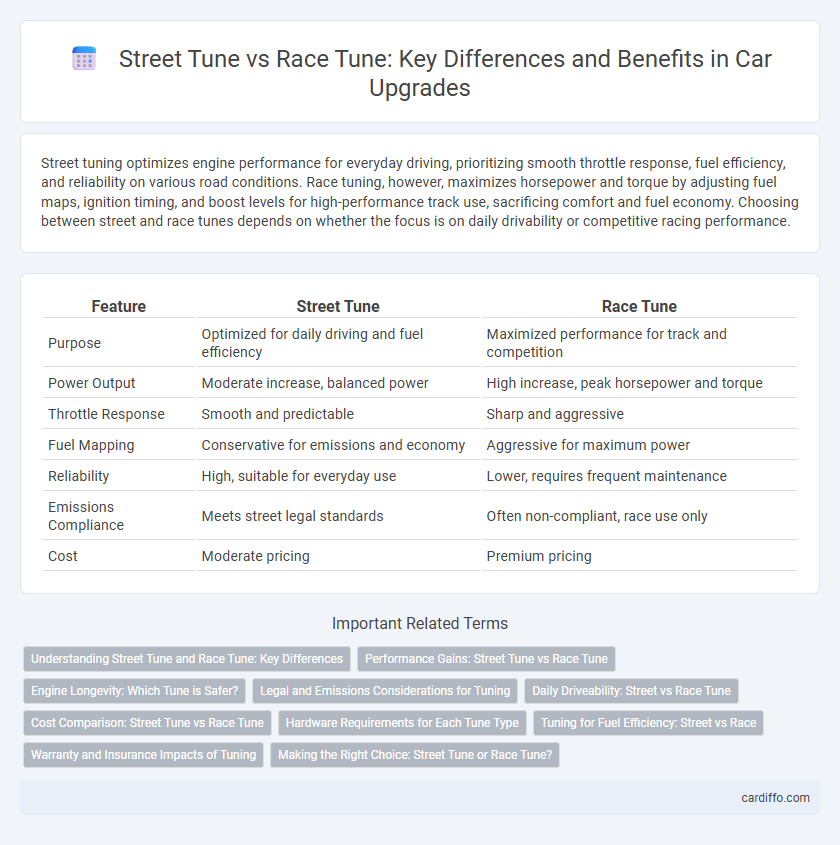Street tuning optimizes engine performance for everyday driving, prioritizing smooth throttle response, fuel efficiency, and reliability on various road conditions. Race tuning, however, maximizes horsepower and torque by adjusting fuel maps, ignition timing, and boost levels for high-performance track use, sacrificing comfort and fuel economy. Choosing between street and race tunes depends on whether the focus is on daily drivability or competitive racing performance.
Table of Comparison
| Feature | Street Tune | Race Tune |
|---|---|---|
| Purpose | Optimized for daily driving and fuel efficiency | Maximized performance for track and competition |
| Power Output | Moderate increase, balanced power | High increase, peak horsepower and torque |
| Throttle Response | Smooth and predictable | Sharp and aggressive |
| Fuel Mapping | Conservative for emissions and economy | Aggressive for maximum power |
| Reliability | High, suitable for everyday use | Lower, requires frequent maintenance |
| Emissions Compliance | Meets street legal standards | Often non-compliant, race use only |
| Cost | Moderate pricing | Premium pricing |
Understanding Street Tune and Race Tune: Key Differences
Street tune optimizes engine performance for everyday driving, balancing power, fuel efficiency, and emissions compliance to ensure reliability and comfort. Race tune sacrifices these factors to maximize horsepower, torque, and throttle responsiveness, often requiring higher octane fuel and enhanced cooling systems. Understanding these differences helps drivers choose the appropriate tune for either daily use or competitive racing scenarios.
Performance Gains: Street Tune vs Race Tune
Street tune optimizes engine mapping for daily drivability, balancing performance gains with fuel efficiency and emissions compliance, typically providing moderate increases in horsepower and torque. Race tune prioritizes maximum power output and responsiveness, often by adjusting fuel delivery, ignition timing, and boost pressure for aggressive driving conditions, resulting in significant horsepower and torque gains at the cost of reduced fuel efficiency and drivability. Performance gains from race tunes can surpass 20-30% over stock settings, while street tunes usually offer 10-15% improvements, making race tunes ideal for track use and street tunes for optimized everyday performance.
Engine Longevity: Which Tune is Safer?
Street tunes prioritize engine longevity by optimizing fuel maps and ignition timing for everyday driving conditions, reducing stress on engine components. Race tunes focus on maximum power output with aggressive settings that increase wear and risk of overheating. For safer long-term engine health, street tunes are recommended due to their balanced approach to performance and durability.
Legal and Emissions Considerations for Tuning
Street tuning prioritizes compliance with local emissions regulations by maintaining factory settings for catalytic converters and oxygen sensors, ensuring the vehicle passes standard emission tests legally. Race tuning often involves modifications that disable or bypass emissions control devices, leading to increased horsepower but resulting in non-compliance with environmental laws and potential legal penalties. Choosing a street tune provides a balanced upgrade that improves performance while adhering to legal requirements and minimizing environmental impact.
Daily Driveability: Street vs Race Tune
Street tunes prioritize Daily Driveability by optimizing engine mapping for smooth throttle response, fuel efficiency, and reduced emissions, making them suitable for everyday use. Race tunes focus on maximizing horsepower and torque with aggressive timing, richer fuel mixtures, and reduced electronic constraints, often sacrificing comfort and fuel economy. Choosing between street and race tunes depends on the balance between performance demands and daily usability needs.
Cost Comparison: Street Tune vs Race Tune
Street tune upgrades typically range from $300 to $800, offering a cost-effective improvement for daily driving performance and fuel efficiency. Race tunes, designed for maximum power and track conditions, often cost between $1,000 and $2,500, reflecting advanced calibration and extensive dyno testing. The significant price difference highlights the balance between budget-friendly enhancements and specialized tuning for competitive racing environments.
Hardware Requirements for Each Tune Type
Street tunes generally demand less intensive hardware modifications, often relying on factory or mildly upgraded components such as intake systems and cat-back exhausts to optimize performance within emissions standards. Race tunes require substantial hardware upgrades, including high-flow fuel injectors, performance camshafts, and upgraded turbochargers or superchargers to handle increased boost and fuel delivery for maximum power output. Supporting systems like enhanced cooling, reinforced transmissions, and advanced engine management units are essential in race tune setups to maintain reliability under extreme conditions.
Tuning for Fuel Efficiency: Street vs Race
Street tuning is optimized for fuel efficiency by adjusting air-fuel ratios and ignition timing to maintain a balanced combustion process, resulting in lower fuel consumption during everyday driving. Race tuning prioritizes maximum engine output, often running richer air-fuel mixtures and advanced ignition timing that significantly increase fuel consumption. While street tune enhances fuel economy and engine longevity, race tune sacrifices efficiency for peak performance under high-stress racing conditions.
Warranty and Insurance Impacts of Tuning
Street tunes often maintain factory safety parameters, preserving vehicle warranty and minimizing insurance risks. Race tunes typically modify engine performance beyond stock limits, which can void warranties and increase insurance premiums. Understanding the implications of each tuning type is essential for maintaining coverage and compliance.
Making the Right Choice: Street Tune or Race Tune?
Choosing between a street tune and a race tune depends on vehicle use and performance goals; street tunes prioritize drivability, fuel efficiency, and emissions compliance for everyday use, while race tunes focus on maximizing power and responsiveness at the expense of comfort and legality. Factors such as engine type, intended driving environment, and local regulations play critical roles in making an informed decision. Thoroughly evaluating these criteria ensures the upgrade aligns with the driver's needs and maintains vehicle reliability.
street tune vs race tune Infographic

 cardiffo.com
cardiffo.com